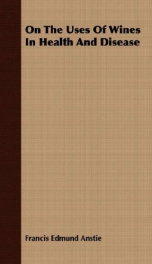on the uses of wines in health and disease

CONTENTS. PAGE P. IKT 1.--ON THE PLACE OF WINES IN TIIX DIET OF ORDINARY L I F E . . . . . . . . . . . . . . . . 1 PART 11.-ON THE USES OF WINES IN DISLASE Section I.-Wines in Acute Disease . , . . . . 42 Section 1I. TVines in Chronic Disease . . . . . 62 ON THE USES OF WINES HEALTH AND DISEASE. ON THE PLACE OF WIKES IN TBE DIET OF ORDIJSARY LIFE. commencing a series of papers on the uses of Wines in health and in disease, we must briefly define the intended scope of our inquiry, in order to avoid misunderstandings. In the first place, it is no part of our object to discuss the question of the .-or t, he advisability of using alcoholic liquors in general, either as food or as medicine we shall take it as established, both by wide-spread custom and by the most recent physiological research, that alcohol as such, has its legitimate place in the sustentation both of the healthy and of the diseased orjjiEiiim. Nor shall we occupy space with the re-assertion of the doctrine, of the absolutely different effects respectively produced by the moderate and by the excessivemuse of this - class of drmks. It is our intention to deal specially with 1-as such to show that the whole group of these beverages has common properties md uses that separate it from other alcoholic liquids and further, that among wines themselves there are very numerous differences, of which many are probably not yet understood either by the public or even by the majority of medical men. We can hardly be mistaken in the latter assertion, sweeping though it seems since not only is it common to meet with invalids and others who have received diametrically opposite directions as to the choice of beverages from different practitioners of equal standing, but we have observed after a pretty close study of this subject, extending over more than thirteen years, that hasty generalizations, which will not bear sifting, are almost as common in the pages of recent as of older writers on this topic. One part of our knowledge has, indeed, of late made solid, though limited advances-viz., the chemistry of wines. But the far wider question of their choice and practical uses is still in the most uncertain state and it must be confessed that recent literature on the subject, though it may have cleared away some gross misconceptions, has almost neutralized this benefit by fostering the growth of new prejudices which are scarcely less unfounded than the old ones. And there is one aspect of the new discussions upon which, though we would willingly ignore it, our duty compels us to animadvert with plainness we mean the influence of commercial motives. We are not imputing conscious dishonesty to the writers even of the most objectionable of the many trade circulars which have been published under the guise of scientific pamphlets on wine but it is only too obvious to those who are at all behind the scenes that commercial bias has in several instances assisted powerfully in the development of exclusive doemas which, from a scientific standpoint, must be regarded as capricious and absurd. It may perhaps be necessary hereafter to illustrate this with some particularity at present it will be enough to adduce an instance which is so common that our criticism of it can scarcely inflict the sting of personal reproach we refer to the clamour for the exclusive use of particular natural or unfortified wines...
Info about the book
Author:
Series:
Unknown
ISBN:
1161680101
Rating:
2.5/5 (5)Your rating:
0/5
Languge:
English
Users who have this book
Users who want this book
What readers are saying
What do you think? Write your own comment on this book!
write a commentGenre
if you like on the uses of wines in health and disease try:
Do you want to read a book that interests you? It’s EASY!
Create an account and send a request for reading to other users on the Webpage of the book!


